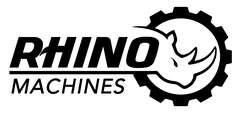Complete Guide: How to Export Used Tires in a Container
Exporting used tires can be a very profitable activity. However, without certain key knowledge, it’s easy to become overwhelmed and encounter unexpected problems.
In this complete guide, we explain from A to Z all the essential steps and information to successfully export your tires, while optimizing your costs and maximizing your profitability.

Our tire export machines
Are you looking for a machine to export used tires? Don’t wait any longer and choose the one that suits you from our catalog.
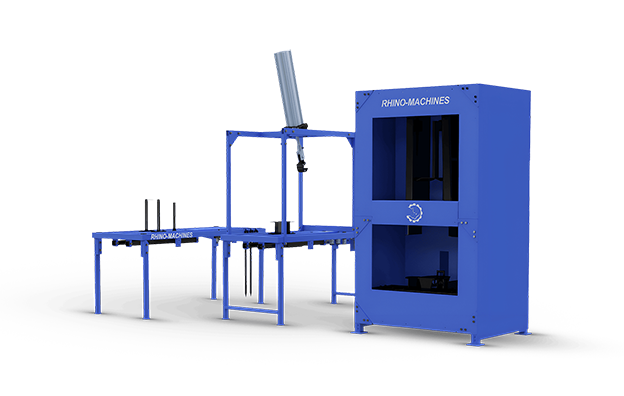
Why Exporting Used Tires Is a Profitable Opportunity?
Tires are an essential component of the automotive industry: no vehicle can operate without them. This is why exporting used tires represents a real opportunity. In many countries, these tires can be purchased by the thousands, offering a high-potential market for professionals and entrepreneurs.
A Growing Demand
In less developed countries, used tires are particularly in demand because they offer an economical alternative to new tires, which are often too expensive for many drivers and businesses. This growing demand creates a dynamic market where quality used tires can sell quickly and in large quantities.
For exporters, this means a unique opportunity to meet a real need while developing a profitable and sustainable business.
A High-Value Product
Whether from wholesalers or garages, used tires can be sold to you at very low prices, or even obtained for free in some cases. Just imagine the potential profit margin you can achieve when exporting them.
In addition to profitability, you contribute to a circular economy by giving a second life to still-usable tires and reducing waste.
And your customers are not limited to car owners: commercial vehicles and motorcycles also represent potential markets for your exports, thus increasing your sales opportunities and diversifying your business.
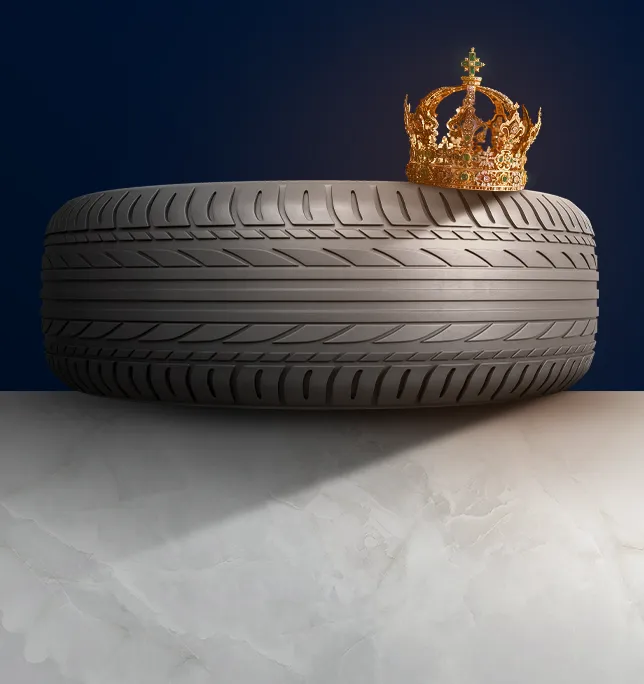
How to Source Used Tires?
You might be wondering: where can you find used tires? There are several sources, but some are more reliable than others. In this guide, we present the two safest options for sourcing used tires, ensuring their quality and reliability for export.
Purchasing from Garages
First, visit the garages around you to collect them for free or at a very low price, depending on the quality. This will be financially advantageous. You will allow the garage owners to avoid paying for recycling, as garages typically pay recycling companies around 150 euros per ton, which equals about 120 tires—a cost they can avoid. They also save on renting collection bins, which is often mandatory.
Purchasing from Wholesalers
Purchasing from wholesalers is possible; however, the wholesaler’s commission significantly reduces profits, and availability is not always guaranteed.
Key Points to Watch When Selecting Tires
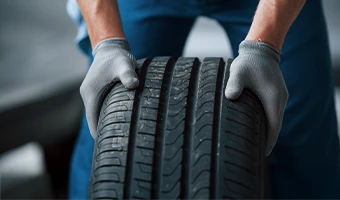
1. Overall Condition: sufficient tread depth, even wear, no cracks or splits.

2. No Damage: no cuts, punctures, dents, or damaged sidewalls.
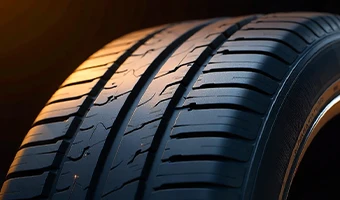
3. Brands and Certifications: prioritize recognized brands and check the manufacturing date and the standards required by the destination country.
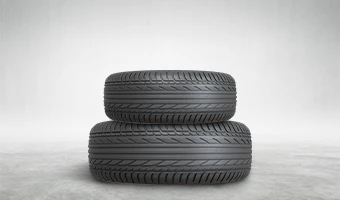
4. Size and Compatibility: choose tires that are popular and suitable for local demand.
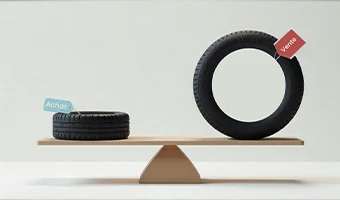
5. Price and profitability: compare the purchase cost to the resale potential to ensure the margin.

6. Pre-shipment check: sort the sellable tires and pack them properly for transport.
How to Load Your Tire Container?
Once you have sourced used tires, the next question is: how can you load them efficiently into containers for export?
Before moving on to loading, there is an essential step to optimize your shipping costs and maximize your profitability: doubling or tripling the tires.
What Is Doubling and Tripling Tires?
Tire tripling is a technique that allows reducing the volume of tires by nesting them inside each other. They are then packed in lots of 3 or more to reduce stock volume, which is a clear advantage during export. Without this technique, instead of sending 1,200 tires, it is possible to send over 3,500 with tire tripling. Without this method, exporting used tires in containers is not profitable due to shipping and customs costs. With it, the generated profits are much higher.

The Advantages of Doubling/Tripling (Space Savings and Reduced Costs)
Simply put, an optimized container can hold the equivalent of three non-optimized containers. By tripling the volume of tires transported in this way, your shipping costs decrease significantly, while your profit margin increases substantially. This method is therefore a key lever for improving the profitability of your used tire exports.
How to Double/Triple Your Tires?
So you might be wondering: how can I double or triple my tires?
Don’t worry, the solution isn’t very complicated. First, you can use two different techniques for doubling or tripling your tires.
The first method, which we do not recommend, is manual: The main reason is that manual tripling requires significant physical effort and is not fast enough for large volumes. There are service providers who do this, but the cost ranges from €0.50 to €3 per tire. For a full container, this can sometimes exceed the price of proper equipment. These providers often perform this as a secondary activity, so their availability is limited, and it can sometimes take several weeks, while the container may already be scheduled. Additionally, the manual method does not respect the natural folding direction of the tires, which can lead to deformation, loss of value, and if the tires are too damaged or improperly inserted, potential customs blockage for waste transport rather than goods transport.
The second is to use appropriate equipment such as a machine for Tripling: The Rhino Machine for Doubling and Tripling, allows the work to be done easily, safely, quickly, and at a low purchase cost. We built the machine to be simple to use, with a single lever. Thus, only one operator is needed, and the learning time is almost zero. The production rate is high and allows completing a batch in under a minute. With the machine, you will maintain control over the preparation of your batches in a safe and productive way, at a lower cost than manual tripling from the very first shipment.
Rhino Tripling Machines: The Easy Solution for Tripling. How to Use It?
Using it is very simple—just follow the three images below. After compressing the tire, select a tire or batch of larger size, insert it around, and then decompress.
This way, you will have completed a doubling or tripling in just a few seconds. Then, repeat as many times as you wish.
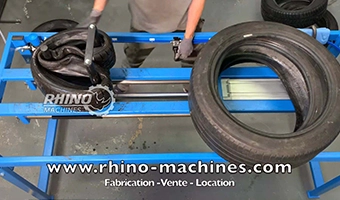
1 – Compress the Tire

2 – Place the tire around.

3 – Uncompress
Get a personalized quote for our tire tripling machine.
Interested in our tire tripling machine? Contact us now for a personalized quote. You can also visit our dedicated page to learn more about its features and benefits.
How to Export Your Tires?
Good, the next step is to export your used tires.
Limited Container Capacity Without Optimization
As mentioned earlier, a poorly optimized or non-optimized container can result in significant financial loss. Take the example of a 40-foot container, the most common size for international export: if shipped without optimization, you could lose up to 66% of your potential profits.
This loss is due to unused space and the container’s under-capacity. On the other hand, by adopting techniques such as doubling or tripling the tires, you fully utilize the available volume, reduce your cost per unit, and maximize your profitability.
How to Fill the Space in Your Container?
To fill the space in your container, make sure you have previously doubled or tripled your tires.
Next, it is preferable to use the chaining technique, which means combining them into each other in the following way:
This technique allows you to maximize the number of tires in a container by using the empty space inside the tires. Note that in this photo, all the tires are the same size, but it is also possible to perform chaining with tires of different sizes.
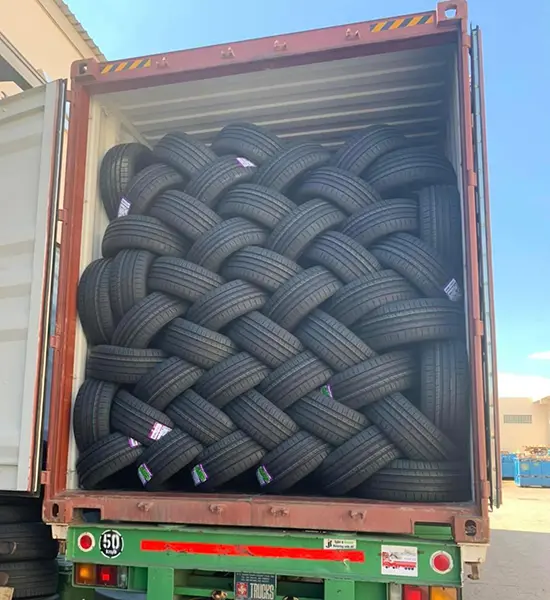
Comparison: Optimized vs. Non-Optimized Container
In summary, an optimized container is equivalent to three non-optimized containers. Its cost per tire becomes much more attractive, and your profit margin is significantly improved. With an optimized container, it is possible to ship up to 3,500 tires, compared to only about 1,200 tires for a non-optimized container.
Conversely, a poorly optimized container leads to additional costs due to repeated shipments and wasted space, which significantly reduces your profits.
Optimizing the loading process is therefore an essential step to maximize the profitability of your used tire exports.
Anticipate and Avoid Customs Issues
It is important to know that regulations for exporting used tires are enforced by customs to prevent the transfer of waste from one country to another.
To avoid any customs blockage, it is important that the tires are not too worn. It is not recommended to ship tires that are too smooth or damaged.
After tripling, it is preferable that the tire has regained its original circular shape. If not, you can usually press inside the tire with your foot so that it fits correctly, thus avoiding customs issues.
How to Unload Your Tire Container?
Congratulations! Your container has been shipped.
But now, how can you unload your tires efficiently? It’s very simple: we will introduce you to the unpacking technique, which will allow you to perform this operation quickly and safely.
What Is Unpacking Tires?
Unpacking Tires is the final step in the logistics process for exporting used tires. After receiving the container, this operation involves removing the tires that were inserted inside a main tire during tripling. It allows each tire to return to its original shape, ready to be used or resold.
Unpacking is essential if you want to mount the tires on vehicles or sell them individually. However, if your goal is simply temporary storage, it is not necessary to unpack immediately: keeping the tires tripled can even make storage easier in narrow or hard-to-access warehouses.
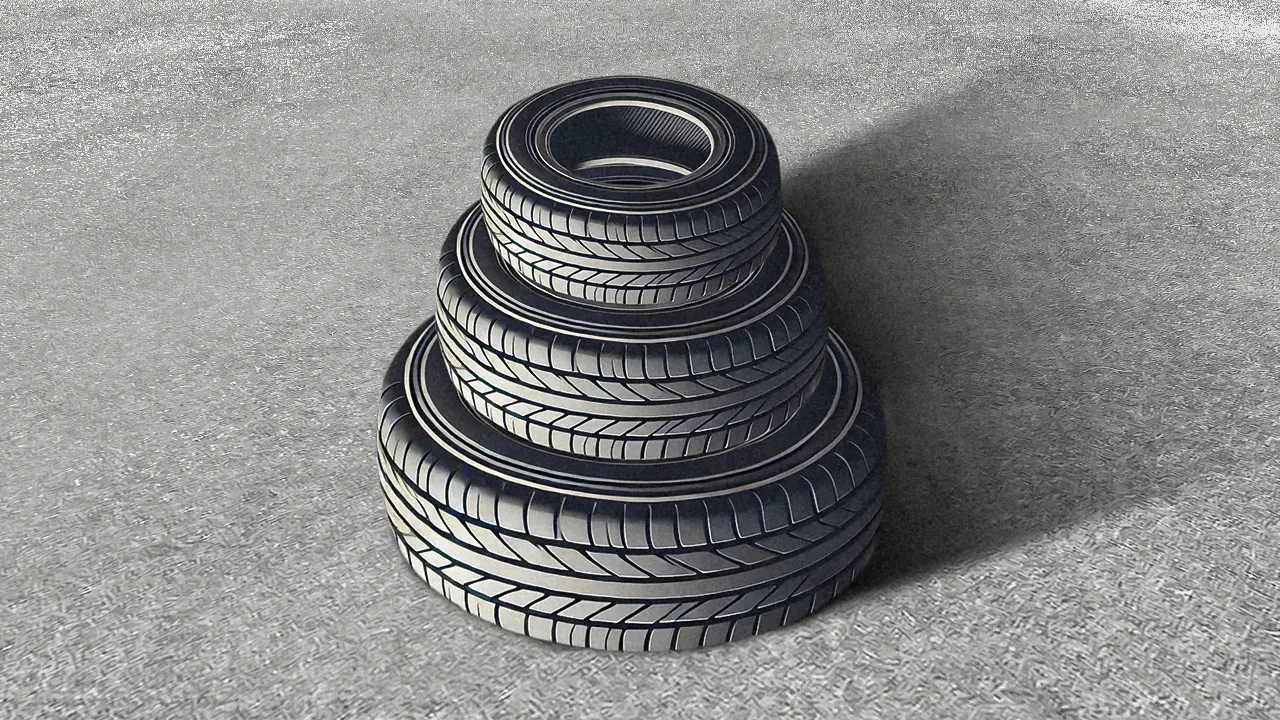
Why Unpack?
Once your tires have arrived at their destination, it is essential to proceed with unpacking. This operation involves carefully separating each tire to restore its original shape and functionality. It is a crucial preliminary step before mounting on a vehicle, resale, or organized storage.
Without this process, the tires remain compressed and deformed, making them unusable. Unpacking thus restores the tires’ condition, facilitates access and valuation, while contributing to an efficient and professional logistics workflow.
How to Unpack Your Tires?
As with doubling or tripling, it is possible to unpack your tires manually. However, this method remains the least safe and least efficient. It involves removing the nested tires by hand, often using basic and poorly suited tools, without mechanical assistance.
In many cases, this task is entrusted to groups of unpackers, often non-professionals, which leads to several drawbacks: prolonged processing time, increased risk of damaging the tires, and variability in work quality.
Furthermore, due to the significant labor involved, manual unpacking can generate high costs without any real guarantee of efficiency. It therefore remains a last-resort solution, to be used only when no suitable equipment is available.
Then, there is the method we recommend, using suitable equipment. Our tire unpacking machine is the safest and most efficient solution for removing nested tires. Specifically designed for this operation, it saves valuable time while preserving the integrity of the tires.
Our machines are designed to provide fast, smooth unpacking that can be performed by a single person. This not only reduces labor requirements but also minimizes the risks associated with improper handling. By keeping the tires in good condition during extraction, the machine helps prevent twisting, deformation, or damage that can occur with manual methods.
How to Use the Rhino Machine for Unpacking?
To unpack your tires, start by gathering the batch of tires to be processed. Then, follow the steps below to perform an efficient unpacking, while preserving the integrity and quality of the tires.

1. Place the batch of tripled tires on the machine.
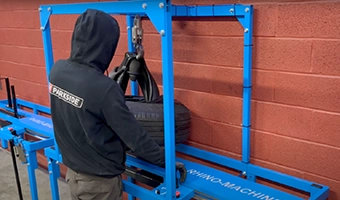
2. Using the hook, grab the innermost tire and then remove it.

3. Repeat the operation until each tire is removed.
Get a personalized quote for our tire unpacking machine.
Interested in our tire unpacking machine? Contact us now for a personalized quote. You can also visit our dedicated page to learn more about its features and benefits.
Conclusion
In conclusion, optimizing your containers is essential to maximize your profits. Use appropriate equipment and manage the occupied space efficiently to transport as many tires as possible while reducing your logistical costs.
It is also crucial to prepare all necessary documents and check the condition of each tire before shipment. This vigilance helps avoid customs issues and ensures that your tires arrive in perfect condition, ready to be resold or used.
Careful planning and rigorous execution of these steps not only ensure the profitability of your operations but also enhance your professionalism and credibility in the international used tire market.
Our tire export machines.
Contact Us
Address
4 avenue Pierre Mauroy, 59280, Armentières
Phone
+33 (0)6 19 89 72 27
Click to show encoded email
